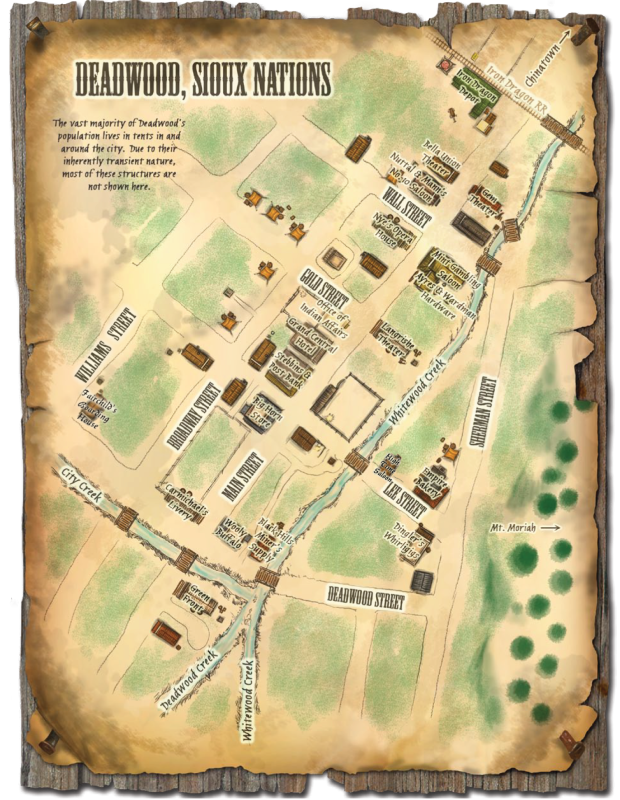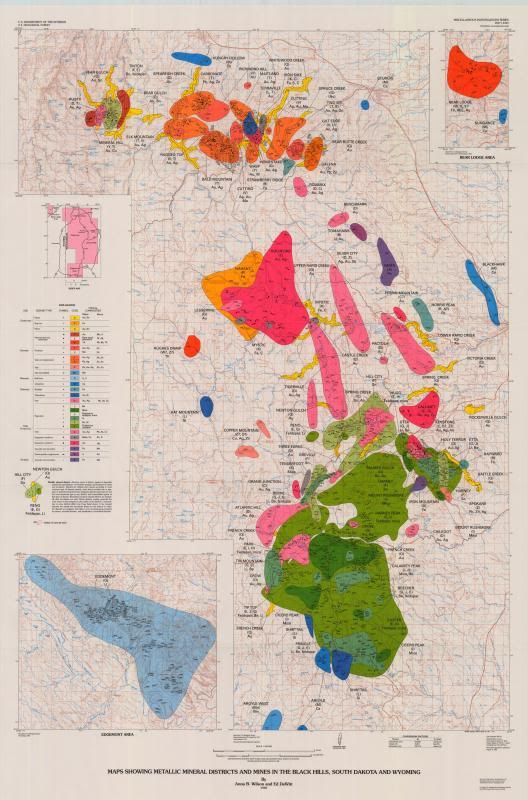 Downtown Deadwood (pictured)
Ayers & Wardman Hardware
Downtown Deadwood (pictured)
Ayers & Wardman Hardware: This fine and well-stocked store specializes in building materials and heavy mining equipment. Fred Ayers is a bit creepy, what with his purple-dyed skin, but most folk say his equipment is the finest in town.
Bella Union Theater: This establishment is owned by Cyrus Tolliver. If you’re looking for a night on the town, you used to be find a variety of drinks, games, and bawdy stage performances here. Thanks to the events of September 12th, the Bella Union was sprayed with the contaminated blood of murder victims collected by Hyrum Burns and his daughter Cynthia. The tainted blood and souls impregnated the Bella Union with a malevolent sentience--it became a Living House. It was subsequently destroyed by dynamite explosion on September 17th.
Big Horn Store: This store is owned and operated by P. A. Gushurst and William Connors. This is the place to go for basic gear and mining equipment.
Black Hills Miner’s Supply: This store offered a wide selection of mining supplies at reasonable prices. During the Great Fire of September 12th, a person or persons unknown attacked the Mining Supply store, killed almost everyone inside, and set the place on fire. The Mining supply store is now a gutted wreck.
Bullock & Star's Outfitters: This store, owned by town marshal Seth Bullock and his business partner Solomon Star, was another hardware store catering to the needs of miners. It was attacked by renegades and burned to the ground during The Great Fire of September 12th.
Carmichael’s Livery: While in town, you can board your trail partner here for $1.50 a day.
Dingler’s Whirligigs: Austrian inventor Arthur Dingler runs this aircraft rental service. An auto-gyro (with pilot) costs $200 a day.
Empire Bakery: Mrs. Ellsner’s cakes and pastries can’t be beat.
Fairchild's Boarding House: One of the few actual houses in Deadwood's business district, no one can say quite when it was built, or who owned it before Elaine Fairchild. Most folk think the place is haunted, but if you're brave enough you can rent a room here for a reasonable $25 a month (meals included). But no hanky-panky--Mrs. Fairchild is a respectable woman and this place is not a brothel in disguise like many of the other "boarding houses" in Deadwood.
Gem Theater: Another good place for a night’s diversion, the Gem was known more for the hospitality of its “hostesses” than the quality of its entertainment. The Gem featured prize fights (although to date, no prizes have been awarded), plenty of liquor, and stage shows as well. On the upper level was a full-service saloon. The owner, Al Swearengen, has ties to the Chinatown opium trade. The Gem burned to the ground during the Great Fire of September 12th after being attacked by Calamity Jane and someone claiming to be Wild Bill Hickok. It's rumored the grounds are haunted, but Al Swearengen has vowed to rebuild.
Grand Central Hotel (Union HQ): The Grand Central has always been the place to stay if you’re just passing through. The grub is excellent; Aunt Lou Marchbanks runs a hell of a kitchen. But rooms aren’t currently available, on account of the Union Army taking up residence and not planning on leaving any time soon.
Green Front: If you’re looking for a lady to spend time with, you’re in the right place.
Langrishe Theater: A respectable theater with solid performances featuring Jack Langrishe and his wife. The Episcopalian congregation meets here on Sundays promptly at 9 a.m.
High Time Saloon: This place is one of three owned by Madam Mollie Johnson, the so-called "Queen of the Blondes." The lovely Madam Johnson doesn't just have blondes working for her--she also has brunettes and redheads, too. It's just that everyone in town agrees her blondes are some of the prettiest girls in town.
Mint Gambling Saloon: This rowdy establishment is run by Kitty Leroy, a trick shooter, gambler, and prostitute, and her German husband.
Nuttal & Mann’s No. 10 Saloon: The site of Wild Bill’s unfortunate demise. Tom Nuttall had roped off the area with curtains and charged folks a dollar to take a gander at the “spot where Wild Bill met his end.” Tom Nuttal met his own end when Calamity Jane and someone claiming to be Wild Bill Hickok risen from the dead attacked the Gem. Though the fire from the gem was extinguished, the No. 10 was left gutted.
Nye’s Opera House: A place to go for those interested in increasing their appreciation of the finer things. It doesn’t get much business, but its few patrons are rich enough to keep it going.
Office of Mining Affairs: Miners are required to register their claims here with the clerk, Joseph Bearclaw. Prospecting permits are available for a fee of $100.
Stebbins & Post Bank: The premier bank of Deadwood. It’s been rumored that the bank may do as much as a hundred thousand dollars a day in business.
Wooly Buffalo: This saloon and gambling hall does the lion’s share of its business with Deadwood’s population of black miners. It’s owned and run by Nat Love, aka Deadwood Dick. The Wooly Buffalo was saved from the Great Fire by the inventiveness of Nat Love and the "Coon General" Sam Fields.
Celestial Alley
Iron Dragon Depot: The depot is one of the busier places in Deadwood. Trains stop at all hours, or pass through to the railhead at the train yards. As the only legal way in or out of the Sioux Nations, prices for tickets are well above the going rate and the railroad bulls are all Kangers armed with swords. More than one would-be hobo has had the misfortune of being tossed from a moving train minus his hands.
The Stage Lines: Those who can't afford an Iron Dragon ticket can try their luck with the semi-legal stage lines that run the road next to the tracks. It's dangerous--the Sioux often attack stagecoaches to prove a point about their legality and road agents have been known to conduct hold-ups--but it's much cheaper than the train.
Warehouses: Freight coming into or leaving Deadwood often makes its way to these unassuming buildings. They're tempting targets for thieves, so Iron Dragon bulls often patrol the buildings at night. They tend to gut first and ask questions not at all.
Wong's Butcher Shop: One of the busiest slaughterhouses in Deadwood, Wong Fee Lee raises most of the pork eaten in Deadwood. Rumors abound that he also disposes bodies for certain folk, grinding them up into feed for his hogs. No one is brave enough to ask him about it, however.
Joss House: This house of the spirits is the major religious fixture of Celestial Alley. This brightly-colored shrine is host to funerals, and the gong they ring during the ceremony can be heard as far away as Deadwood Street.
The Cathouse: Of the thirty or so Chinese women who live in Celestial Alley, only about a third are wives. The rest make their living either as seamstresses, launderers, or prostitutes. The Cathouse is one of the larger brothel/opium dens on the Celestial Alley. Owned by Maria Delgato, the place is known for the cats kept on the premises--a subtle marketing pun on Delgato's part, allowing her to claim to have the best pussies in town.
House of Heavenly Delights: This opium den is run by Huang Li, and caters to those who have a hankering for something a little stronger than whiskey. At night you can smell the burning opium from a block away. This establishment also feature cockfighting, mahjong, and fan-tan.
Hou's Laundry: One of several laundries in Celestial Alley. This one is notable for being the one most
gweilo (that's a not-very-nice term for non-Chinese folk) visit when they need their longjohns cleaned, as Je Hou and his wife Je Lan both speak fluent, if accented, English.
Jade Garden: This restaurant specializes in traditional Chinese cuisine and is reasonably priced. However, the service for non-Chinese is noticeably poor. There have been reports of servers claiming to be "out" of a particular dish to Caucasian customers while in the process of serving that exact dish to Celestial customers. Or the servers pretend to be deaf. Or meals taking so long to arrive that people get fed up and leave, or....you get the picture.
Other Notable Locations
The Iron Dragon Railyard: Southeast of town is the main railhead for the Deadwood spur of the Iron Dragon line. The railroad bulls here tend to be especially vicious toward intruders, so tread carefully if you're going to poke around. Rumor has it that construction has begun on a new spur south of town, possibly headed for Laramie. Other rumors claim the spur is for a secret mining camp Kang's set up illegally in the Black Hills. No one has gotten close enough to confirm either rumor.
Deadwood Miner's Alliance Stockade: This fortified compound is the main training grounds for the Deadwood Miner's Alliance. It serves mostly as a meeting hall for those in the DMA full-time, Deadwood's
de facto militia. Most members of the DMA are just miners who want to remain protected from the Sioux and are willing to pay dues to the DMA and serve one day out of the month guarding claims. The full-timers tend to be those with more interest in gunplay than mining, and usually act as hired muscle for claims of members in good standing (i.e. those who've paid up). Those who
haven't paid their dues to the DMA, well...not only are they on their own, but the Sioux tend to wreck their claims substantially more often, or they have visits from claim jumpers or the "ghost miners" (supposedly the angry souls of those killed in the Deadwood Massacre of '75). It's not
quite a protection racket, since the DMA does, in fact, go after claim jumpers and Sioux raiders, but it's within the ballpark.
Pole Man Road: Large groups of Sioux patrol the area around Deadwood, and anyone caught violating the terms of the Deadwood Creek Treaty is dragged back to town behind a horse or ejected from the nations--if they're lucky. The corpses of those who fight back can be seen hanging from poles along the main trail leading into the Black Hills, a warning to those who would violate their host's hospitality. Miners who travel the road every day are forced to look at these grisly remains. There's a wild rumor that there are more bodies here than were actually killed by the Sioux, and that on rainy nights the dead men on the poles slide off and attack any lonely miner passing beneath, adding them to their number.
This message was last edited by the player at 19:38, Thu 02 Feb 2017.








